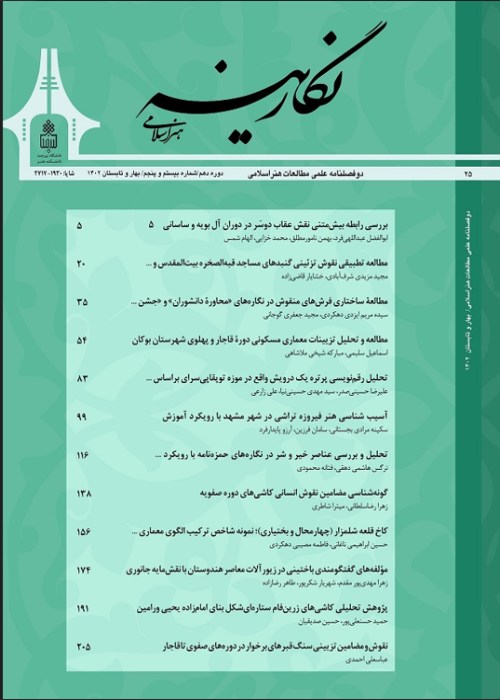Analysis of the Painting “Humayun and Akbar Meeting" with emphasizing on the Varieties of the Artist's Presence in the Artwork
In the process of producing the artworks, the artist either considers himself/herself bound by certain stylistic and scholastic principles, or goes beyond it and lays the foundations of another style. Meanwhile, in works where stylistic and scholastic codes have a strong presence, there is less opportunity for the presence of the artist's personal codes. Iranian painting is one of the arts that due to the heavy presence of stylistic and scholastic rules, the presence of the author in it faces many challenges and limitations. But it seems that in the contexts in which Iranian painters have been able to free themselves to some extent from these restrictions, some forms of the presence of these personal codes have also spread. One of these contexts is the "Indo-Iranian" school, which was founded by Iranian artists in India. This research deals with the stylistic and thematic analysis of the painting “Humayun and Akbar Meeting” which belongs to Indo-Iranian school. The research is based on the assumption that this work is a distinctive example in terms of using different forms of artist presence in an oriental painting. Therefore, the main question is what are the different types of the artist's presence in the “Humayun and Akbar Meeting” painting? The research method was descriptive-analytical in the process of which the stylistic, written and thematic layers of the image were studied. The results show that the artist's stylistic loyalty to the Iranian tradition of Tabriz school, especially the mobility and dynamics of the figures and the type of composition of Behzad's paintings, recording the artist's figure in the inscription and in the text itself, is an example of the artist's personal codes in the work. Also here and in a very rare phenomenon in the oriental art, we see the visual presence of the artist himself in the painting and also the representation of the image of the whole painting in the work, which in addition to being the most important form of the author's presence in the work, makes the “Humayun and Akbar Meeting” a distinct artwork. This research deals with the stylistic and thematic analysis of the painting of “Majles-e Homāyoun va Akbar" of this school. The research is based on the assumption that this work is a distinctive example in terms of using different forms of the artist's presence in an Oriental painting. The main question can be posed like this; what are the different types of the artist's presence in the "Majles-e Homāyoun Akbar" painting? The research method is descriptive-analytical in which the stylistic, written and thematic layers of the image are studied. The results show that the artist's stylistic loyalty to the Iranian tradition of Tabriz school, especially the movement and dynamics of the figures and the type of composition of Behzad's paintings, recording the artist's figure in the inscription and also in the text of the work itself, are examples of personal artist codes in the work under study. In very rare phenomena in Oriental art, we see the visual presence of the artist himself in the painting and also the representation of the image of the whole painting in the work. These forms of the artist's presence, in addition to being the most important form of the author's presence in the work and turning “Majles-e Homāyoun and Akbar" into a distinct work, .
- حق عضویت دریافتی صرف حمایت از نشریات عضو و نگهداری، تکمیل و توسعه مگیران میشود.
- پرداخت حق اشتراک و دانلود مقالات اجازه بازنشر آن در سایر رسانههای چاپی و دیجیتال را به کاربر نمیدهد.



